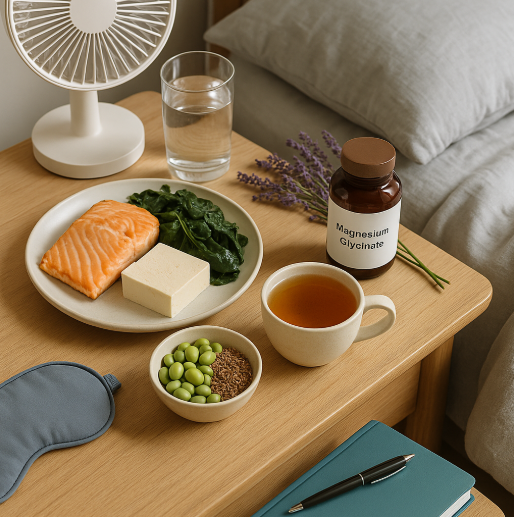Table of Contents
I thought the AC had failed, it was January and freezing outside, when the first hot flash jolted me awake. I kicked off the covers, drank cold water in the dark and watched the clock creep towards morning, as I got used to this new normal. It wasn’t until a few months later, that I found out my night sweats were no longer random. My cycles were unpredictable, my nerves were on high and small things felt louder. Almost like my nervous system had lost its padding. My friends told me “This sounds like perimenopause” a label I didn’t want. I wanted, if not a name then a sense of relief that I could feel in my body. But, if that’s what you’re up against, there’s a play book that took me through it, my diet, vitamins, sleep routine.
What perimenopause is doing in the background
When going through perimenopause you’re actually in a period of transition, not a single day, where estrogen and progesterone levels can fluctuate erratically and make you feel those changes, like hot flashes and night sweats, anxiety-ridden wake-ups at 3 a.m., lousy sleep that falls apart at the seams and mood swings that seem to come out of nowhere.
Well-known medical associations say these symptoms are very real, extremely common and, more importantly, can be treated. If someone ever told you it was all in your head, disregard that, you now have a doctor’s seal of approval to challenge that claim. The American College of Obstetricians and Gynecologists lays out that mood swings and sleep problems are just part of the landscape for lots of women in perimenopause, kind of like a severe and extended PMS. You’ll be hearing a lot about hormone therapy, and for good reason.
It’s the go-to solution for hot flashes and night sweats, and for many women, brings better sleep as a secondary effect. The suitability of hormone therapy for you will depend on your age, the stage of your transition, your family and personal history and what matters most to you, and it’s my aim here to give you the lowdown, so you can have a knowledgeable conversation with your healthcare provider. The North American Menopause Society is crystal clear in its recommendations, too: hormone therapy is number one for any woman who is bothered by hot flashes, especially early in the transition.
Food as a daily thermostat
Concerning food, I used to see it just as calories, protein and carbs, but that changed for me when I entered perimenopause. I found out that certain meals really set off my hot flashes, others brought them down to almost nothing, and all it took was a few simple tweaks to sort out which is which. Well-known principles suggest starting every meal with a combination of protein, fiber and healthy fats to steady blood sugar levels and then found that when I made the switch to eating more beans, lentils, leafy greens, whole grains, nuts, seeds and fish, I noticed fewer post-meal spikes and a smoother ride through the afternoons. This isn’t magic, it’s basic physiology, and fibre is what slows down the release of glucose and sends happy signals to the gut microbes, who produce anti-inflammatory short-chain fatty acids that calm the body’s thermostat. The Mediterranean diet may be supported by some studies of midlife women, and seems to be linked to cardiometabolic health, and even symptoms in some cases, but there’s a bit of mixed opinion and work still to do, so I’m not counting on miracles.
Protein was something I didn’t know much about before I started really monitoring it. I’ve now found that hitting a significant protein target. One that’s spread across my meals, rather than slammed down at dinner. Knocks out my 4 o’clock crashes, gives me better workouts, and reduces my late night snacking. The underdog of nutrition is fibre, which most of us don’t get enough of, roughly 25 to thirty-five grams per day. Coming from a big serving of lentil soup, a chickpea salad, or oatmeal are pretty much guaranteed to sort me out, and were not uncommon in my diet. It was by accident I stumbled upon resistant starch, but now make a habit of cooling and re-heating rice, potatoes and quinoa, and turning them into something that’s much kinder on blood sugar levels, and feeds the good bacteria in my gut. The change doesn’t come overnight, but gives me a steady baseline that starts to calm down.
The soy question, answered like an adult
You’re not the only one who did, when hearing that soy will mess with your hormones as a child. Coming from a family or culture that’s traditionally eaten soy, it’s no wonder that the words “soy” and “estrogen” got stuck together. Well-known plant compounds found in soy, isoflavones, can very weakly bind to estrogen receptors, and research on this topic is showing mixed results.
Some studies say they can calm down hot flashes and night sweats, others don’t see much of a difference. In 2025, one major analysis finally found that soy had no estrogenic effects on some of the things we worry about most, such as cancer markers and bone density, in postmenopausal women. So, all you need to know is that traditional soy foods like tofu, tempeh, miso and unsweetened soy yogurt are decent protein-rich options to try and see what they do for you, over a four to six week period, if anything, with one to two servings a day.
Fermented foods as quiet helpers
When I first turned to fermented foods, it wasn’t because I wanted to be trendy. It was because my gut was fragile and my sleep was all over the place, and a daily or two of yogurt, kefir, kimchi or sauerkraut sort of fixed everything. Well-known Stanford researchers found that a diet that includes fermented foods, boosts the diversity of our gut microbiome and knocks down inflammation in adults, which just happens to be associated with calmer digestion and. You guessed it steadier sleep. I think about it as training the microorganisms that govern my body’s ecosystem, and in turn, calm my nervous system. And because it’s basically no-risk, inexpensive, and deeply rooted in cultural heritage, it’s something I can stick to.
The caffeine and alcohol reality check
I wanted to believe that my coffee was harmless, but it wasn’t, when I started the day. I pushed my last cup back to before noon, and I’m glad I did, because my night sweats improved. Coming hotfooting to bed after a drink is still a bad idea. A glass of wine within a couple of hours of bedtime guarantees a 2 am heat wave. Well-known factors contribute to this process, thermoregulation, blood sugar levels and sleep patterns, but the one thing that stands out is that the price you pay for a nightcap is a stolen morning, and that’s not relaxing. It’s expensive. I now only reserve alcohol for nights where the return is worth it, eat it with food, and monitor my intake, and set limits.
Supplements: what actually helps, what to approach with caution
Examining supplements, I view them as tools to be used in combination with a foundation of good health. For me, omega-3s from fish or high-quality fish oil are a standout supplement. As a mood stabilizer and joint comforter, they really get the job done. The research is still in its early stages for menopause, but it’s evident from numerous reviews and tiny trials that fish oil has a positive impact on mood, sleep and even hot flash frequency with no apparent negative effects.
If you’re on blood thinners, or you’re getting surgery, talk to your doctor before adding fish oil to your regimen. Magnesium particularly in the form of glycinate is now part of my unwinding ritual. Although the official insomnia guidelines do not rank it as a number one therapy, it’s used as muscle relaxant and general sleep enhancer by so many clinicians, and because we’re not getting enough of it through food. I see magnesium as a gentle scaffold that can provide the foundation on the road to retraining sleep itself. As regards melatonin, I don’t see it as a sedative.
It’s basically a hormone that helps to calm you down. In perimenopausal and postmenopausal women, recent randomised trials indicate that melatonin can boost sleep and all sorts of symptoms that women are plagued with in this phase. Coming from someone who’s been in the thick of it, I believe that low, early doses work better than those larger “stronger” bottles you see everywhere. An autoimmune condition or taking a handful of medications, talk to your doctor before starting anything new, because vitamins and calcium aren’t as straightforward as they seem, when you’re experiencing migraines.
Vitamin D is a must-have for bone health, but a US Preventive Services Task Force review showed that routine supplementation won’t do much to prevent fractures in generally healthy postmenopausal adults, and now advises against using vitamin D with or without calcium for that purpose. Well-known levels, sunshine, healthy diet, and supplements can cover the bases if you’re deficient or at risk, but a single pill isn’t enough to stave off fractures, and should not be used as a fall-back plan, because that’s still up to the individual’s exercise routine, protein intake, and strategies to prevent falls.
The National Institutes of Health recommend a daily intake of 600-800 IU of vitamin D, with a top limit of 4,000 IU. But your doctor’s lab results and prescription should be used to set your dosage. Herbal remedies are also worth mentioning; black cohosh, which is used by many for hot flashes, may have rare liver problems, so the NIH, and LiverTox warn of the potential. If you’re considering herbal remedies, inform your doctor and understand that not all things are risk-free, and “natural” doesn’t mean they won’t cause problems.
Sleep: the symptom behind every symptom
Everything in my life started to feel more even out. The hot flashes were less intense, my patience returned, and healthy eating became the norm, when my sleep improved. Menopause-related sleep disturbance is a fairly predictable pattern, lots of awakenings after falling asleep, difficulty getting back to sleep, and the feeling that I’m not getting the restorative sleep that I need even when I do manage to fall asleep. Coming to understand this pattern took a weight off my shoulders and allowed me to start creating a plan.
Cognitive behavioral therapy for insomnia, or CBT-I, became the backbone of that plan. This isn’t generic sleep advice, it’s a very structured, time-limited treatment that essentially reconditions how your body and brain respond to sleep, and has proven to be the most effective non-drug intervention for chronic insomnia in adults, even outperforming sleeping pills in the long run. Well-known elements of CBT-I include stimulus control, circadian anchoring and restricting the amount of time spent lying awake in bed to build up the pressure to sleep.
After a few sessions with a therapist, I had a validated digital program that helped me stay on track. The first two weeks were tough, but the weeks that followed felt like getting back on the right path, bit by bit. To deal with the night sweats, I’ve combined the CBT-I treatment with practical measures. Moving my workouts to the day time, dropping the temperature in my bedroom, and treating my bed as its own microclimate. Using breathable sheets, a fan that’s angled across the mattress, and a glass of water right next to my bed. Since I found out that alcohol before bedtime makes the night sweats even worse, I made a rule for myself to cut off any drinking by a certain hour.
How to knit food, supplements, and sleep into one compassionate routine
Repetition is, when thinking back on my most helpful week I’m reminded that perfection isn’t the goal. Coming hotfooting out of bed, starting the day with a protein-rich breakfast that includes fermented foods. Such as unsweetened yoghurt with berries and chia seeds or tofu scramble with leafy greens, is pretty much standard for me. My lunches are usually Mediterranean inspired, a big bowl of lentil soup with a side salad and olive oil, or chickpeas over cooled and re-heated rice, flavoured with herbs.
Well-known as a general rule, I don’t drink coffee in the afternoon, herbal tea is my preference, and hard liquor is kept for social occasions and definitely not for bedtime. I take my omega-3s with my main meal, magnesium glycinate in the evening, and melatonin is reserved for those really rough nights, at a very low dose and much earlier than you’d think. I’ve got a pretty regular routine, with consistent bedtime and wake-up times, if I wake up in the middle of the night I get out of bed, dim the lights, and quietly sit reading until I feel sleepy again. That last part is by far the hardest for me. One of the things I’ve learned to do is track patterns in a simple way, without turning myself into a human experiment. A few notes on my phone hot flashes, alcohol, exercise, stress and sleep. Revealed triggers that I wouldn’t have otherwise known. Coming face-to-face with my reality after three under-slept nights, the day I presented at work, confirmed in writing what my body already knew. That sleep is the keystone, not a luxury that can be postponed.
A gentle closing for a loud season
And that’s normal, but it can be disconcerting, when going through perimenopause you can start to feel disconnected from who you used to be. Coming to terms with a new body, and dealing with unrecognizable food, supplements and sleep can be a challenge. Well-known as a recipe for disaster, relief from these perimenopausal symptoms is rarely achieved by making one huge change, it’s really about piling up lots of smaller, evidence-based decisions that you make day after day, and being kind to yourself when they don’t all work out.
Eating to stabilise blood sugar levels and support the gut microbiome is a good place to start. Supplements should be used with a clear understanding of what you’re putting into your body. Sleep is a skill that can be re-learned and cognitive behavioural therapy for insomnia, CBT-I, is an excellent coach. It’s also never too early to discuss hormone therapy, because a treatment plan that suits your values and body will be vastly different from someone else’s, and is not always reflected in social media. You’re allowed to want your energy back, sleep through the night, and feel like yourself again, and now is the time to set out on the path towards making that happen.



